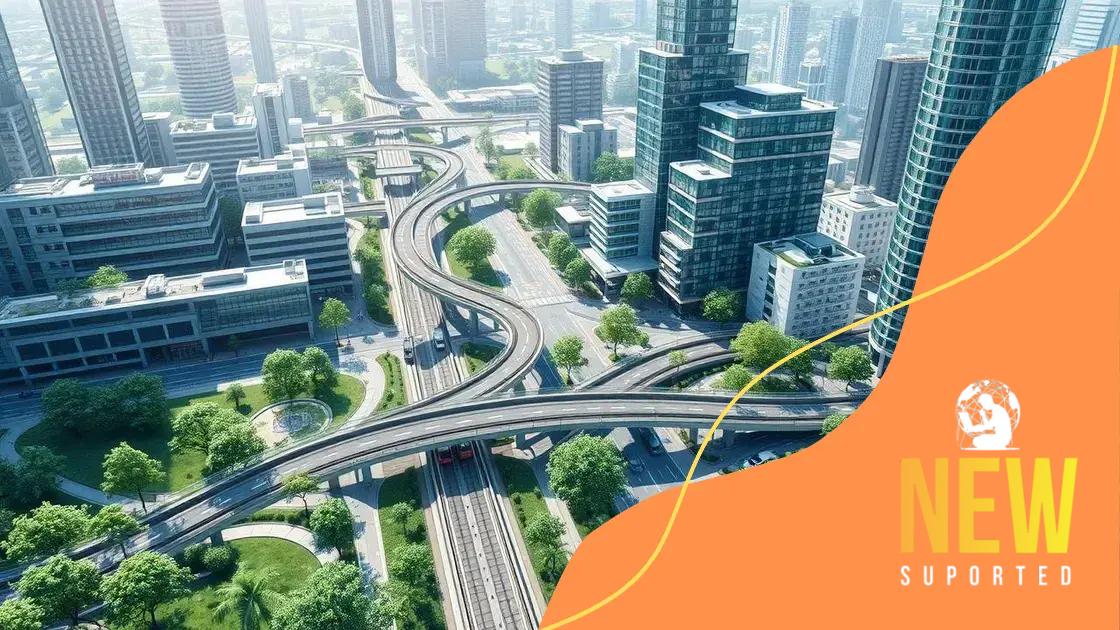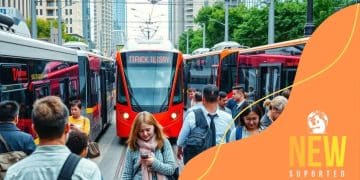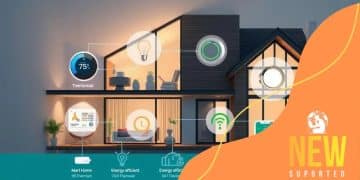How smart cities are tackling urbanization challenges

Smart cities tackle urbanization challenges by leveraging technology, enhancing public transportation, engaging communities, and implementing sustainability initiatives to create efficient and livable urban environments.
How smart cities are tackling urbanization challenges might just change the way we think about urban living. From traffic management to energy efficiency, solutions are emerging that are designed to enhance our daily lives. Are you ready to discover how these innovations shape our future?
Understanding smart cities and their goals
Understanding smart cities and their goals is essential as we move into a future of rapid urbanization. These cities utilize technology to improve the quality of life for residents while also addressing challenges such as traffic congestion and environmental sustainability.
Smart cities focus on using data and connectivity to create efficient urban environments. They aim to integrate information and communication technologies (ICT) in managing urban assets. This process allows for smarter decisions that enhance overall living standards.
Key Goals of Smart Cities
The core objectives of smart cities include:
- Enhancing public safety through advanced surveillance systems.
- Reducing energy consumption with smart grids and renewable energy sources.
- Improving transportation efficiency with real-time public transit data.
- Promoting community well-being by increasing access to services.
By focusing on data-driven decision-making, smart cities aim to tackle urban challenges head-on. For instance, using sensors and the Internet of Things (IoT), cities can monitor traffic patterns, helping to reduce stop-and-go traffic that often leads to frustration.
How Technology is Integrated
Another key aspect of smart cities is their reliance on various technologies. Urban planners incorporate both hardware and software innovations to address the complex dynamics of city life. This integration helps cities adapt quickly to changes.
Technologies like big data analytics and machine learning contribute to making urban environments more responsive. These technologies provide valuable insights that help city officials make informed decisions about resource allocation and infrastructure development.
Through engaging with residents, smart city initiatives also encourage community involvement. This collaboration can lead to solutions that are not only sustainable but also tailored to the specific needs of the population.
Thus, smart cities represent a shift towards more proactive urban management, utilizing technology to enhance quality of life while addressing pressing challenges of urbanization. The focus lies not only on technological advancements but also on forging deeper connections with the community to ensure everyone benefits.
How technology is optimizing urban planning
How technology is optimizing urban planning is a key part of building smarter cities. Cities today are leveraging advanced technologies to make their layouts more efficient and livable.
Urban planners rely on data and smart systems to make decisions about land use, transportation, and public spaces. Technologies like Geographic Information Systems (GIS) help visualize city layouts. They allow planners to assess land use, zoning laws, and infrastructure needs effectively.
Benefits of Technology in Urban Planning
Using technology brings several advantages:
- Data-driven insights lead to better decision-making.
- Real-time monitoring helps manage resources efficiently.
- Sustainability initiatives are easier to implement.
- Public engagement improves through interactive platforms.
With real-time data, cities can respond swiftly to changing conditions. For example, traffic data informs transport planning, ensuring roads are built where they are needed most. This minimizes congestion and enhances mobility for residents.
Additionally, technology fosters community interaction in planning processes. Public forums and online surveys allow citizens to provide input on projects. Engaging locals helps ensure developments meet the community’s needs and desires.
Innovative Tools Shaping Urban Design
Many cities are adopting innovative tools to reshape their urban spaces. 3D modeling allows planners to visualize structures before they are built. This technology helps spot potential issues and fosters better collaboration among stakeholders.
Beyond modeling, cities use simulation software to test various planning scenarios. Such tools enable planners to evaluate the impacts of decisions on traffic flow, environmental factors, and community interactions. This foresight is critical for sustainable development.
Ultimately, technology in urban planning enhances efficiency and responsiveness. As cities grow, smart technologies will play an even greater role in shaping livable urban environments, balancing growth with the well-being of residents.
Public transportation advancements in smart cities

Public transportation advancements in smart cities play a crucial role in enhancing urban mobility. These innovations aim to make commuting more efficient, affordable, and eco-friendly.
Smart cities utilize technology to improve public transport systems. Real-time tracking apps allow passengers to monitor bus and train arrivals, reducing wait times and enhancing convenience. This access to information empowers commuters to plan their journeys effectively.
Benefits of Advanced Public Transportation
Improving public transportation offers numerous benefits:
- Decreased traffic congestion, as more people choose mass transit over cars.
- Lower greenhouse gas emissions, contributing to a greener environment.
- Enhanced accessibility, making it easier for everyone to travel.
- Cost savings, as public transport is often cheaper than owning a vehicle.
These factors lead to greater overall community well-being. When public transport systems are efficient and reliable, more residents opt for this mode of travel, which decreases the number of vehicles on the road.
Innovative Technologies in Public Transport
Smart cities are now integrating various technologies into their transport systems. For instance, electric buses and trams are becoming more common. These vehicles contribute to reducing air pollution and reliance on fossil fuels. Additionally, automated systems streamline operations, allowing for more reliable schedules.
Moreover, some cities are experimenting with mobility-as-a-service (MaaS) platforms. These services integrate different transport options—like buses, trains, and ride-sharing—into a single accessible app. Users can plan and pay for their trips in a seamless manner.
In summary, advancements in public transportation systems in smart cities signify a step toward more sustainable and efficient urban living. By focusing on technology and innovation, cities can better serve their residents, making commuting a more enjoyable experience.
The role of community engagement in urban development
The role of community engagement in urban development is vital for creating cities that meet the needs of residents. Involving the community allows for better decision-making and fosters a sense of ownership.
When urban planners include public input in projects, they gain valuable insights about local needs and preferences. This leads to designs that resonate with the community and enhance livability.
Benefits of Community Engagement
Engagement brings numerous advantages to urban development:
- Increased trust between residents and city officials.
- Empowerment of local voices in decision making.
- Better project outcomes that reflect community wishes.
- Enhanced collaboration among diverse stakeholders.
By building strong relationships with residents, urban developers can work together with the community to solve challenges. These collaborations create vibrant neighborhoods with a focus on safety, accessibility, and inclusivity.
Methods for Community Involvement
There are various effective methods cities use to engage their communities. Open town hall meetings allow residents to express their ideas and concerns directly. Additionally, online platforms make participation easier, reaching a broader audience.
Surveys and feedback forms are another way to gather opinions. These tools help planners understand community needs. When cities ask for feedback on projects like parks or transportation routes, they can tailor solutions accordingly.
Ultimately, incorporating community engagement into urban development ensures that cities evolve in ways that truly benefit residents. Engaged communities contribute to urban planning efforts, leading to sustainable and vibrant living environments.
Sustainability initiatives in smart cities
Sustainability initiatives in smart cities are essential for creating environments that are not only livable but also eco-friendly. These initiatives focus on reducing the carbon footprint and promoting resource efficiency.
Smart cities implement a variety of practices to enhance sustainability. By utilizing technology, cities can monitor energy usage and reduce waste, leading to significant environmental benefits. For example, smart grids optimize energy distribution, ensuring that renewable sources like solar and wind are utilized effectively.
Key Sustainability Practices
Several sustainability practices are common in smart cities:
- Implementing green building standards to improve energy efficiency.
- Promoting the use of public transportation and non-motorized transport.
- Encouraging urban farming and green roofs for local food production.
- Enhancing waste management through recycling programs and composting.
These practices not only support environmental goals but also enhance the quality of life for residents. When cities invest in green spaces and efficient transport systems, they create a healthier urban environment.
Technologies Driving Sustainability
Cutting-edge technologies play a crucial role in achieving sustainability in smart cities. For example, IoT devices can track air quality and energy levels, providing real-time data for better management. This data helps cities to respond quickly to environmental challenges and make informed decisions.
Another innovative approach is the use of smart waste bins that signal when they are full. This system optimizes waste collection routes, reducing fuel consumption and emissions.
Ultimately, sustainability initiatives are not just about technology; they reflect a city’s commitment to building resilient communities. By prioritizing eco-friendly practices, smart cities can ensure a healthy future for their residents and the planet.
FAQ – Frequently Asked Questions about Smart Cities
What are smart cities?
Smart cities use technology and data to improve urban living, enhance sustainability, and manage resources efficiently.
How do community engagement initiatives impact urban planning?
Community engagement allows residents to share their needs and preferences, leading to urban designs that reflect the community’s wishes.
What technologies are commonly used in smart cities for sustainability?
Technologies like IoT devices, smart grids, and data analytics help monitor resources and optimize energy use in smart cities.
Why is public transportation important in smart cities?
Efficient public transportation reduces traffic congestion, lowers emissions, and provides access to essential services for all residents.






